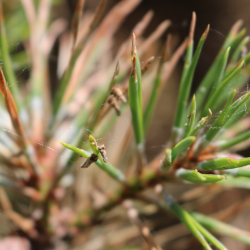May 12, 2020
Scout Now to Control Bagworms this Spring
Submitted by Cassie L Wandersee

A Kansas Forest Service official says mid-May is an important time to start scouting for bagworms, a perennial problem that affects many trees common to Kansas landscapes.
Ryan Armbrust, the forest health coordinator with KFS, said bagworms negatively affect ornamental landscape conifers, windbreak trees like eastern redcedar and arborvitae, and Scotch pine Christmas tree farms.
“While deciduous broadleaf trees can recover from the defoliation that bagworms cause, conifers are often severely impacted, and sometimes killed outright by large infestations of bagworms,” Armbrust said.
In the spring, overwintered eggs hatch and small larva begin to feed on leaves and needles of the tree. At this stage, they are called “crawlers” and are most easily controlled.
Armbrust said it is important to start scouting now for effective control of bagworms, before they begin to form the protective casing of plant debris that they get their name from, and become more difficult to control.
He explained that many insecticides are labeled to control bagworms, but timing and coverage must be carefully planned to ensure effectiveness. Bagworms are best controlled by timing sprays to May or June, depending on how early spring arrived. Armbrust added the emergence of larvae usually peaks between the bloom time of black locust and catalpa, so it is helpful for homeowners to watch the trees to signal that it’s time to start scouting for bagworms.
“When bagworms are in the ‘crawler’ stage, just a fraction of an inch long, they are most sensitive to chemical control,” he said. “Full coverage, including penetrating the tree’s interior canopy, is needed. Low-pressure consumer-grade sprayers are not usually adequate, and commercial treatment may be more effective.”
When crawlers are small, the organic selective insecticides Bt (Bacillus thuringiensis, subspecies kurstaki) or spinosad can be effective. Armbrust said these insecticides do not impact beneficial insects like broad-spectrum options, which sometimes lead to resurgent populations of spider mites that further damage treated trees. However, if the early window for treatment is missed, broad-spectrum insecticides containing malathion, carbaryl, acephate, or cyfluthrin may be better options.
Unfortunately, he notes, “once these pests are hunkered down in their protective cocoons, they are largely protected from chemical treatment options that we may attempt to control them with.”
Bagworm populations are dependent on environmental factors, including bird populations that feed on adult bagworm moths, and therefore experience population peaks and valleys.
“Infestations may be severe for several years, only to subsequently drop below damaging levels for several years, giving trees time to recover, which they often do,” Armbrust said.
For more information on controlling bagworms, reference the publication, Bagworm: Insect Pest of Trees and Shrubs, from K-State Research and Extension.